Reading the Pulps 8: “Solar Plexus” by James Blish
“Solar Plexus” by James Blish original appeared in the September 1941 issue of Astonishing Stories.
You can find this story in these anthologies, which include:
- Beyond Human Ken (1952) edited by Judith Merril
- Men and Machines (1968, 2009) edited by Robert Silverberg. This version can be read online via Google Books.
- The Great SF Stories 3 1941 (1980) edited by Asimov & Greenberg
Warning: This essay contains spoilers.

“Solar Plexus” by James Blish isn’t a famous story. As far as I can tell, it was never included in any of Blish’s short story collections, and there were over a dozen of them. He must not have liked it much.
I was intrigued by “Solar Plexus” because it was first published in 1941 and contained words that shouldn’t have been used that year. I read “Solar Plexus” in The Great SF Stories 3 1941 edited by Isaac Asimov and Martin H. Greenberg. Either James Blish had access to secret research, was very good at extrapolation and coining words, or he had access to a time machine. Of course, the easy answer, Blish revised this story when it was reprinted for book publication. I wish he hadn’t.
I also wish I had access to a copy of Astonishing Stories September 1941 so I could read the original. Unfortunately, the cheapest copy I could locate for sale is $35 plus $15 for shipping. I’m not going to spend $50 to solve a minor literary mystery.
The first phrase that set off warning bells was “the UN’s police cruiser.” The United Nations was established in 1945. I supposed Blish could have guessed the phrase United Nations from the United States.
The next word that caught my attention was “computer.” In 1941 people used the word computer to mean humans that worked at mathematical calculations, not machines. But still, he could have imagined the language changing.
After that came “transistor radio.” The transistor was invented in 1947, and the transistor radio was first developed in 1954. I assumed Blish rewrote “Solar Plexus” in 1952 for the Judith Merril anthology. Now I’m wondering if he revised it again for the 1968 Robert Silverberg anthology Men and Machines.
Blish also used the word, “astronaut” which has been around for various uses, but I’m not sure it was used the way Blish used it in 1941 for space-traveler. I think NASA made that popular, and NASA was created in 1958.
Blish is credited with coining the term “gas giant” but I find that very hard to believe. Technovelgy says the term wasn’t used in the 1941 version but was in the 1952 revision of the story. Even Wikipedia gives him credit. So, wow!
In my research for this story, I found out that Blish constantly revised his short stories. I consider that a kind of cheating when considering the SF speculation aspects. I love reading old science fiction to understand how people in the past thought about the future. Science fiction never predicts the future, but it does speculate and extrapolate. That’s the art of science fiction.
I assume the basic plot of “Solar Plexus” was the same in 1941 despite the updating of terminology. In the story, Brant Kittinger is an astronomer living in a space habitat orbiting a newly discovered gas giant in our solar system. His work is interrupted when a spaceship arrives and connects to his airlock. Kittinger is tricked into going into the new ship where he discovers it’s controlled by a sentient computer that was once Murray Bennett.
This is the earliest science fiction story I know that presents a cyborg spaceship. Bennett had his own body destroyed, incorporating his brain into a ship’s control system. Blish talks about nerve-to-circuit surgery which science is working on today. Cyborgs have a long history as a concept, and science fiction has had many stories about sentient spaceships, including the popular The Ship Who Sang (1969) by Anne McCaffrey.
The plot of “Solar Plexus” is rather simple. Bennett wants to use Kittinger’s brain to create other ships. But the computer mind struggles to understand motivation and purpose. Of course, Kittinger doesn’t want his brain recycled for spaceship parts. Luckily for him, Bennett has another captive on board, a Lt. Powell, and the two of them figure out how to outwit the ship.
I was troubled by the ending though. I didn’t want Kittinger and Powell to kill the sentient ship. However, they have no qualms about doing it. From the same collection, The Great SF Stories 3, I read Isaac Asimov’s story “Liar!” where we are introduced to Susan Calvin. Calvin coldly murders a sentient computer too. Evidently, back in 1941, there was no empathy for AI minds.
I would have been more impressed with Blish if he had created a sympathetic cyborg. Fiction is driven by conflict, and the easiest threat to create in writing is one of bodily harm. That’s why intelligent computers are mostly seen as nightmare killers because unimaginative authors can’t invent a better complication for the conflicts of their stories.
James Blish didn’t lack imagination, just read “Surface Tension.” “Solar Plexus” would be a better-remembered story if it hadn’t been about another mad scientist wanting to harvest brains. Of course, Astonishing Stories wasn’t a top-tier pulp, and 1941 was still early in Blish’s career as a writer.
That said, I try to imagine what it might have been like to be a teen reading a copy of Astonishing Stories in the fall of 1941. The concepts of space travel, spaceships, computers, weren’t highly developed in the public’s mind back then. “Solar Plexus” showed a lot of creative imagination.
I wish science fiction writers wouldn’t revise their stories. Or if they do, date them some way. We should have “Solar Plexus,” “Solar Plexus (1952)” and maybe even “Solar Plexus (1968)” listed in ISFDB. I wish Asimov/Greenberg had used the 1941 version in their collection. Of the three volumes I’ve read so far, I think one introduction mentioned using the original rather than the revised story.
JWH
Reading the Pulps #5: Visual Memory and Nostalgia
Is an aspect of nostalgia an ache to see things we once owned or coveted? On Facebook, there are countless groups where members post images driven by nostalgia. At Space Opera Pulp over eleven thousand people enjoy pictures from old science fiction books and pulp magazines covers. Raypunk, which has a modern slant has over twenty-three thousand members. There are photo nostalgia groups of all kinds. I also belong to ones that remember old movies, westerns, cars, mid-century houses, graphic artists, Baby Boomer memorabilia, etc. I don’t know why, but some of the most nostalgically powerful images for me are old book and magazine covers.
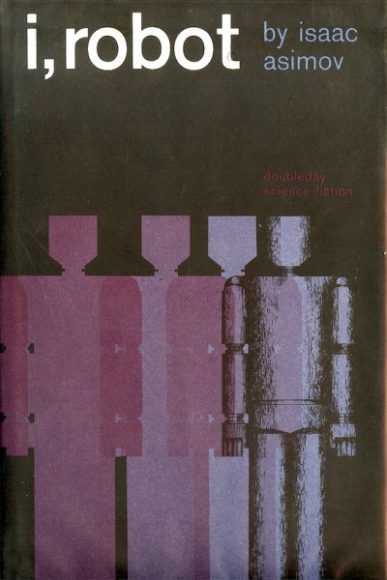 I recently created a cover gallery, “The Hardback Legacy of Astounding Science Fiction” for my blog. It was an excuse to gather .jpg images of all the first edition books that reprinted content from Astounding Science Fiction magazine (1930-1960). I love looking at artwork that illustrated old science fiction stories. For that post, I narrowed it down to hardbacks. Some people have commented they remember the same books by their paperback covers. Then last night on Young Sheldon I saw Sheldon reading a copy of I, Robot with the cover I had for the Science Fiction Book Club edition I first read. Man, that released a flood of nostalgia-chemicals in my brain. I wonder how many older viewers had a deep twinge of longing for the past when they saw that scene?
I recently created a cover gallery, “The Hardback Legacy of Astounding Science Fiction” for my blog. It was an excuse to gather .jpg images of all the first edition books that reprinted content from Astounding Science Fiction magazine (1930-1960). I love looking at artwork that illustrated old science fiction stories. For that post, I narrowed it down to hardbacks. Some people have commented they remember the same books by their paperback covers. Then last night on Young Sheldon I saw Sheldon reading a copy of I, Robot with the cover I had for the Science Fiction Book Club edition I first read. Man, that released a flood of nostalgia-chemicals in my brain. I wonder how many older viewers had a deep twinge of longing for the past when they saw that scene?
Are the covers we remember most the ones we saw first?
Shown above, is how I remember I, Robot. When I look at all the other covers for I, Robot they don’t tweak my nostalgia like this SFBC edition cover. I even wonder if I’m nostalgic for the stories at all, but instead long to see the book I once held while enjoying the stories?
I use two ways to find cover images. The first one, which is the quickest method, is with a Google search then clicking the image tab. The results look like this:

Google tends to get the most popular images, and often throws in stuff that’s not related. The way below was created using ISFDB.org. It requires typing a query into its database, and sometimes it takes a little skill. Regular use will reveal it’s tricks. First, find the main entry for the book you want by typing in the title and then selecting “Fiction Titles.” Hit Go. Click the title link to the proper entry. Then scroll down to the bottom of that list and click on all “View all covers for …” Here are the early covers for I, Robot in publication order. Click on the link to see all.

This got me to thinking. Is a big aspect of nostalgia related to what we owned or wanted to own when we were teens? Even if its something popular before our teen years? I turned 13 the year the Ford Mustang and Plymouth Barracuda came out in 1964. So images of 1960s muscle cars light up my nostalgia neurons. Generally, pictures of anything that happened in the 1960s turn on my nostalgia. But so do images from 1930s movies and 1940s pulp magazines, things that came out way before I was born. What explains that? They are past pop culture I learned to love in my teens. Why do we imprint so strongly what we experienced from age 10-20? Why don’t I have nostalgia for stuff I discovered in my forties? Maybe I will in my eighties.
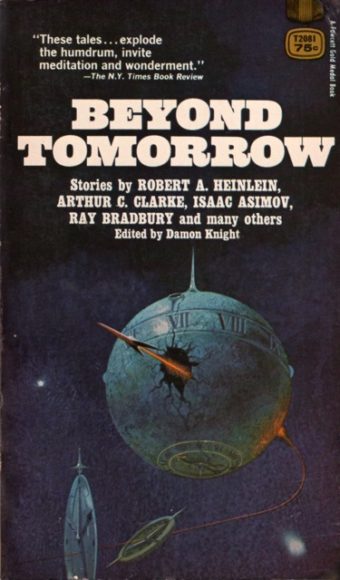 My friend Mike told me how he loved a paperback copy of Beyond Tomorrow, a paperback anthology edited by Damon Knight, which he said he read to pieces. That made me remember something else. I love covers from many science fiction books, but I’m always partial to the editions I first read.
My friend Mike told me how he loved a paperback copy of Beyond Tomorrow, a paperback anthology edited by Damon Knight, which he said he read to pieces. That made me remember something else. I love covers from many science fiction books, but I’m always partial to the editions I first read.
For example, I hate seeing any cover for the twelve Heinlein juveniles except those from the original publisher Charles Scribners Sons. However, I do accept the covers from the pulp digest magazines where the stories first appeared. When I started collecting pulp magazines the first thing I did was collect the mags that contained stories by Heinlein.
Thus, these are the acceptable images I have for Have Space Suit-Will Travel. By the way, Worlds Without End causes me endless memory heartache because they often use covers I don’t associate with a title. If you click on the title link above you’ll see one I particularly dislike. In fact, I dislike all the covers for Have Space Suit-Will travel but these two:
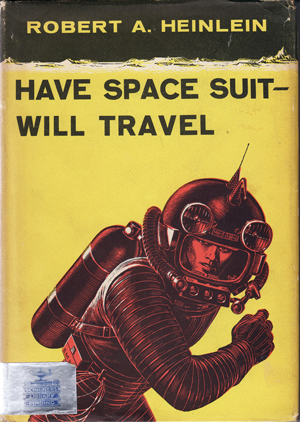

They were both done by Emsh (Ed Emshwiller). Do you also have this hangup about book covers? If so, leave a comment. I’m curious how visual memories affect other people.
Someone commented on my blog that they remember the paperback covers instead because they didn’t buy hardbacks or get science fiction from the library. I remember having several sources of science fiction. First were library books I got at school, or the Homestead Air Force Base Library or the downtown main branch of the Miami Public Library. This is where I saw all those first edition hardbacks I show off on my blog. That’s why I remember hardbacks along with paperbacks.
When I began making my own money in the 9th grade mowing lawns and having a paper route, I started going to used bookstores on my bike or buying new paperbacks off of twirling racks in drugstores. Used bookstores are where I began seeing old paperbacks and digest pulp magazines covers that have been burned into my brain. In the tenth grade, I joined the Science Fiction Book Club and began collecting hardback editions. Their covers are also etched deep in my memories. My formative mind imprinted on those covers and I’m now haunted by them. I wonder how long this bout of nostalgia will last?
Joachim Boaz has been tweeting photos of his bookshelves. Not only does this trigger nostalgia, but envy. In my lifetime I’ve owned thousands of books and magazines, but I’ve given most away. When I read the titles on Joachim’s shelves I see so many I once owned. His old paperbacks trigger so many memories. I wonder if Joachim is less nostalgic than I am because he owns all those books that I can only remember when I see a photograph.
SFFaudio also tweets and retweets images that often sets off my nostalgia. They also show a lot of interior art, as well as table-of-contents pages and images of pages to read from the past. From all the photos they tweet I can tell they also have the nostalgia flu.
Yesterday I went to the public library and went up and down the ranges that held their science fiction collection. Most of their science fiction is newer and I don’t remember those books at all. And the older books I do remember have later editions that look unfamiliar to me. Except for a few rare finds, this experienced evoked no nostalgia. It was sad. I had hoped to find books I saw on the shelves back in the 1960s, but they are long gone. I did find a third printing of the first edition of A Canticle for Leibowitz. And I found a couple early Brian Aldiss story collections from the 1960s.
Maybe another reason my mind responds so well to photos is that I have a poor visual memory. Well, my memory for stories is also poor. Maybe what I call nostalgia is just the pleasure of recall itself. I don’t know. But for the fun of it, here’s how I remember Robert A. Heinlein. Astute observers will notice I have no nostalgia for Heinlein after 1966.
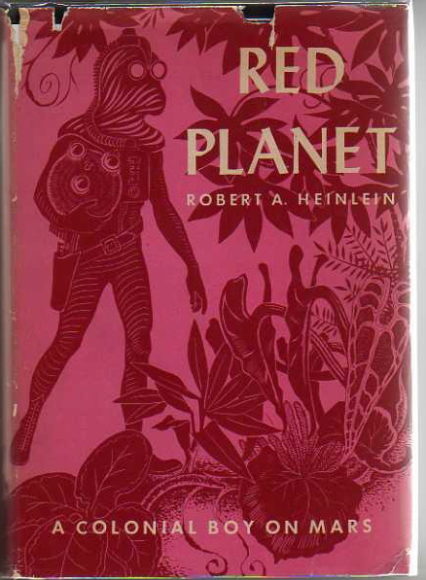
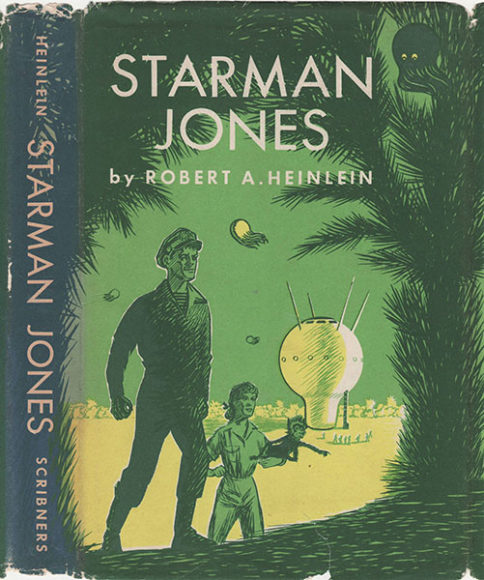
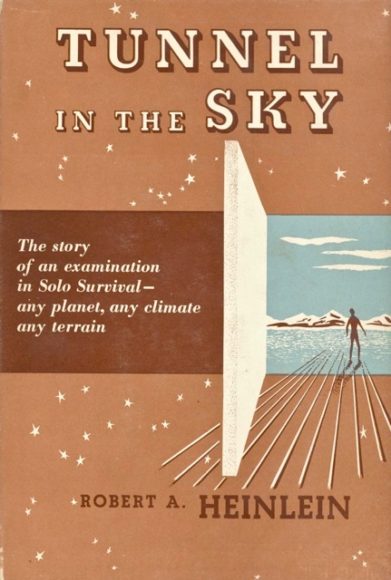
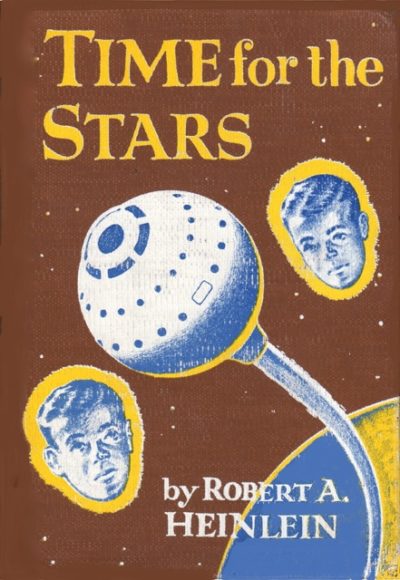
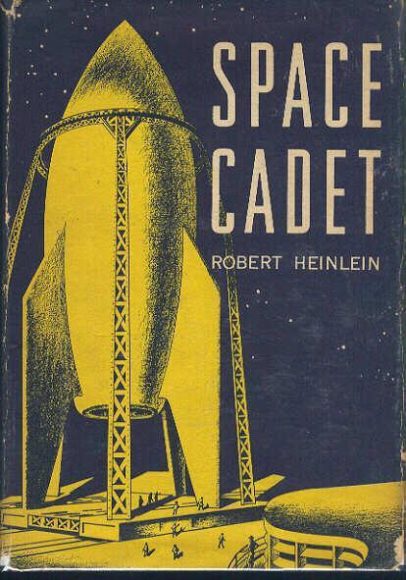
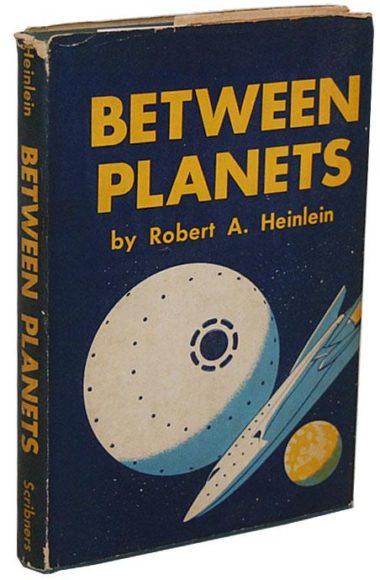
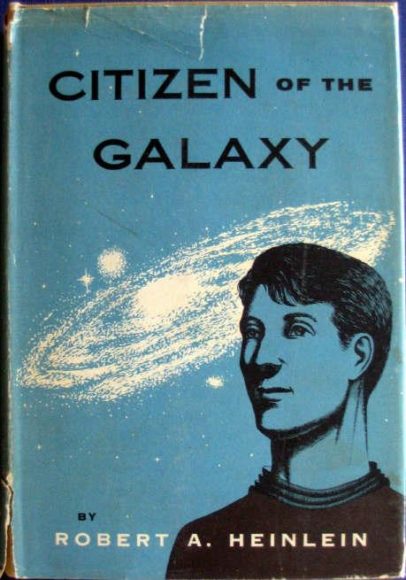
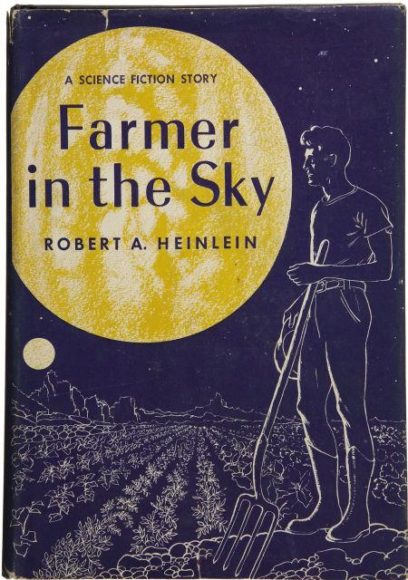
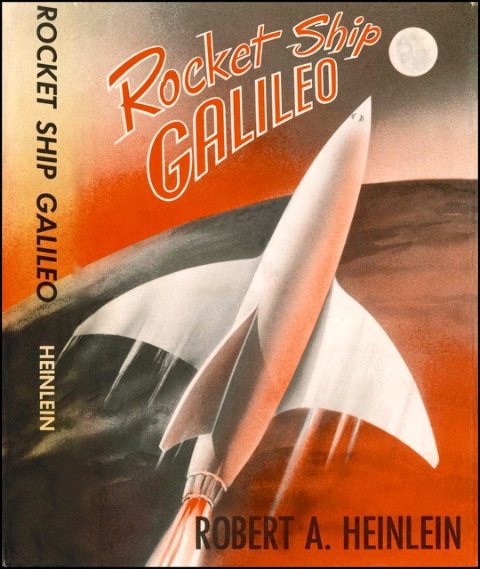
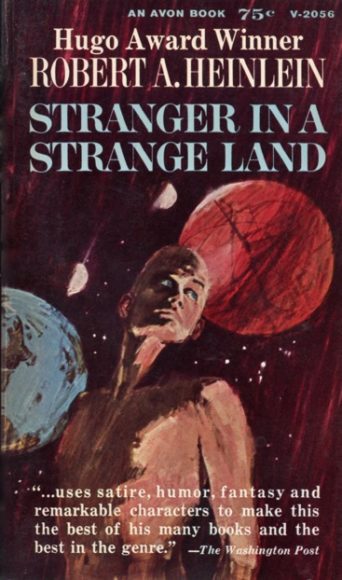
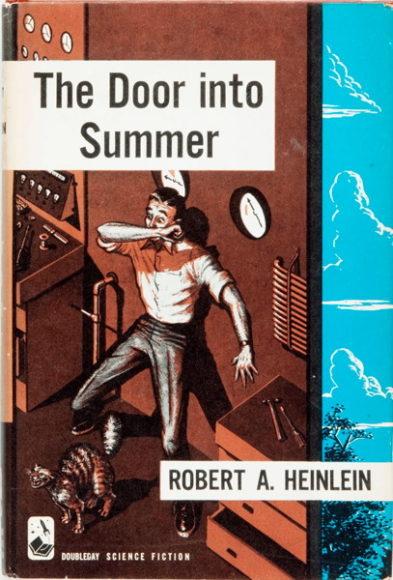
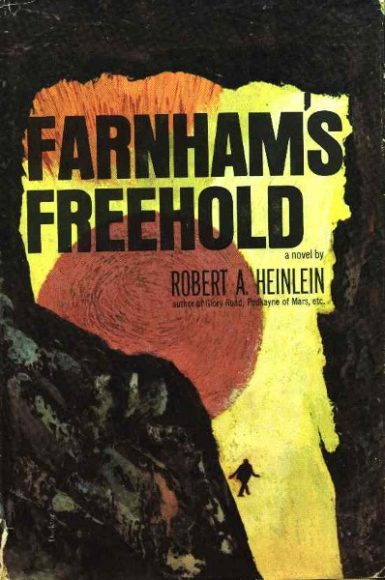

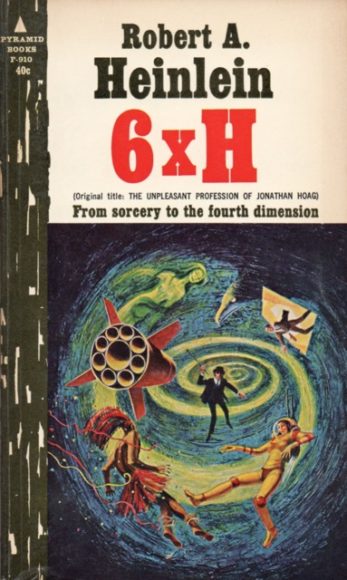
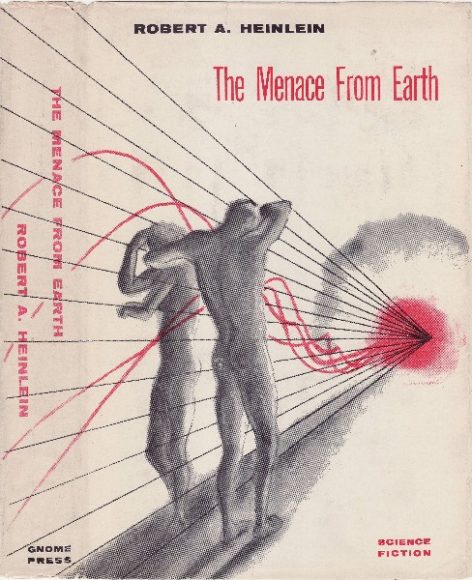

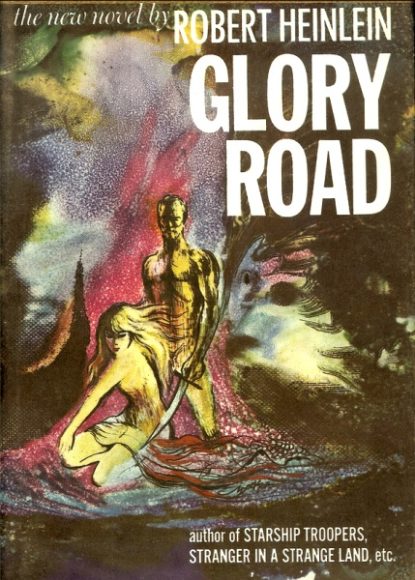

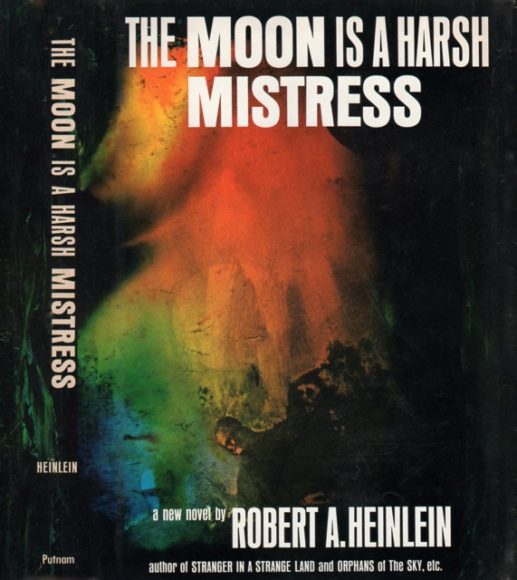
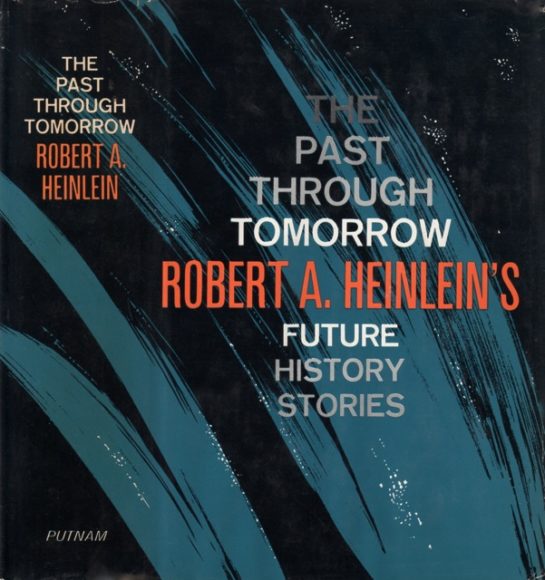
JWH
Should Science Fiction Be Rational?
 In the book Fantasyland: How America Went Haywire: A 500-Year History by Kurt Andersen catalogs countless ways in which America is irrational. Andersen is an admirer of Philip K. Dick, and quotes/mentions him more than once, including one very long passage where Andersen says he couldn’t explain things better than PKD. However, Andersen connects science fiction several times to irrational thinking, and sometimes I get the feeling he thinks science fiction is a catch-phrase for nutty ideas.
In the book Fantasyland: How America Went Haywire: A 500-Year History by Kurt Andersen catalogs countless ways in which America is irrational. Andersen is an admirer of Philip K. Dick, and quotes/mentions him more than once, including one very long passage where Andersen says he couldn’t explain things better than PKD. However, Andersen connects science fiction several times to irrational thinking, and sometimes I get the feeling he thinks science fiction is a catch-phrase for nutty ideas.
Here’s one quote, “Like so much pseudoscience, mesmerism was faulty science fiction, a fantasy inspired by a misunderstood bit of reality” – is Andersen defining science fiction as fantasy literature that misunderstands reality?
The last science fiction novel I read was Chocky by John Wyndham. Its premise is telepathy exists and works instantaneously across the vast distances of space. Wyndham in his story proposes that matter is limited to the speed of light but not mind, and thought has no speed limit. Chocky is a far distant alien that possesses a 12-year-old British boy. Of course, this idea is descended from Star Maker by Olaf Stapledon. I consider alien mind travel a fun meme for fantasy stories, but the philosophical disciples of Shirley MacLaine would testify under oath that’s how reality actually works.
Here’s another quote, where he talks about L. Ron Hubbard:
“Hubbard had a brazen indifference to the line between nonfiction and fiction—specifically science fiction, and not just e-meters. Scientology’s theological backstory is staggeringly ridiculous sci-fi, 2001 meets Star Trek meets Star Wars meets The Matrix meets Prometheus. In short, each of us contains a thetan, one of the ethereal beings who created the universe but each of whom, after being shipped to Earth and hit with nuclear bombs by the evil dictator of the Galactic Confederacy, was brainwashed to forget its godlike origins and believe in the false reality most people consider real.”
You have to admit that Scientology is whacked, but then so are the ideas in those TV shows and movies. We think of them as fun. Andersen claims 2/3rds of our society think of them as gospel.
Fantasyland is a book everyone should read because it defines our times better than any book I’ve read in the 21st-century. However, as science fiction fans we need to ask ourselves some very serious questions. Andersen makes an overwhelming case that America has become irrational with about two-thirds of its citizens rejecting science and rational thought. How much has science fiction contributed to the emerging paradigm of believing anything is possible because believing is what powers our reality?
If you don’t think this is true, then I plead for you to read Fantasyland. It is the Future Shock of this generation. To show I’m not holier than thou, I wrote “22 Dumb Fantasies I’ve Tried to Believe” at my blog. I’ve since realized I could have easily doubled or tripled that number.
Science fiction is as tainted as New Age philosophies when it comes to pseudo-science. Cleaning up the genre will be just as hard as convincing society at large to think scientifically. I doubt it’s even possible. But shouldn’t we try? Should science fiction take a position in the current war of the irrational on the rational? If you think that last sentence is hyperbole, then read Fantasyland.
Expanded Universe by Robert A. Heinlein Narrated Bronson Pinchot
Bronson Pinchot does such a fantastic job narrating Heinlein’s old book Expanded Universe (now reprinted in two volumes) that I picture Heinlein sounding like Pinchot. On one hand, I recommend Heinlein fans buying these audiobooks because the narrator brings these old stories into a fresh light, but on the other hand, I also recommend everyone NOT buy these books as a protest against how they are being sold. Encouraging publishers to reprint single-volume books as two volumes makes a terrible precedent!

I hate that the Blackstone Audio has followed Phoenix Pick, the current publishers of the ebook/paperback editions of Expanded Universe, by selling Expanded Universe as two audiobooks. This is an absolute rip-off! I didn’t buy it on Audible because I didn’t want to waste two credits on one book. It is worth one credit to fans who want to complete their Heinlein on audio, but not two.
I refused to buy these two-volumes until I saw them on sale at Downpour for $4.95 each. In a weak moment, I crossed my own picket line. So I guess I recommend buying the two-volume audiobook edition if you can get them in a 2-for-1 deal. Even then that galled me! It’s annoying to have one book broken into two parts in my library.
If you just want to read Expanded Universe, I recommend getting the original single volume used at ABEbooks. There are many copies available for less than $4 including shipping.
Can you imagine if it became standard to sell old books in two parts so the publisher can charge twice as much? Expanded Universe isn’t even a large book. On audio, the two volumes run just over 18 hours. Many new science fiction novels run longer. New York 2140 by Kim Stanley Robinson is 22 hours and 34 minutes long. Hell, one credit at Audible can get me The Complete Sherlock Holmes (58 hours) or The Complete Short Stories of J. G. Ballard (65 hours). To expect fans to use two audiobook credits for a medium size audiobook that’s essentially the dregs of Heinlein’s trunk stories is not fair at all.
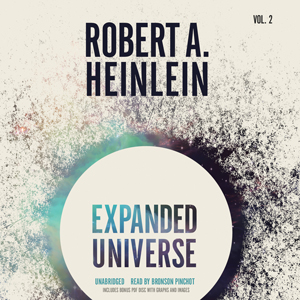
Expanded Universe has always been a kind of publishing rip-off. Expanded Universe reprints a small Ace Book from 1966 called The Worlds of Robert A. Heinlein which I already owned. The first book contained four of Heinlein’s older stories along with one new story, “Free Men” that had been written in 1947 but never published. Sort of like buying an album of older so-so songs with one unpublished out-take as a sales come-on.
In 1980 Ace expanded this little book as The New Worlds of Robert A. Heinlein Expanded Universe. That was an honest enough title, expanding those original five stories to twenty-seven, with introductions. It’s a nice collection of Heinlein’s rejects, forgotten works, and a few famous early stories that would appeal to his hardcore fans. Still, it’s yet another repackaging of Heinlein for his ardent fans. The best of these stories were already in the classic Past Through Tomorrow collection.
Before now, I never really like Expanded Universe or The Worlds of Robert A. Heinlein though. The less famous stories always seemed dated and slight, and few famous stories were in multiple other collections. That is until I heard Bronson Pinchot read them. Most of the stories are from the 1940s and feel moldy. But when listening to Pinchot read them I realized what Heinlein had been trying to do back then, and it’s far more impressive than I ever gave him credit. For example, some of the stories were written before we dropped the A-bomb on Japan, or just after, and they are now eerily relevant again because of Kim Jong-un.
Many of these forgotten stories reveal better characterization and writing than Heinlein gave his readers after 1965. But they also reveal the seeds of his later obsessions. Expanded Universe is a must for people studying Robert A. Heinlein.
Other stories are minor delights for Heinlein fans who enjoy observing how Heinlein progressed as a writer. For example, “They Do It With Mirrors” is Heinlein’s attempt at writing a mystery story, even including his pet fetish for nudism. Because many of the stories have introductions you get a bit of biography with this book too.
I divide Heinlein’s writing into four periods – the 1940s, the 1950s, the 1960s, and everything after 1970. Heinlein thought his best work was Starship Troopers (1959), Stranger in a Strange Land (1961) and The Moon is a Harsh Mistress (1965) and wanted to be remembered for those three books. I thought he peaked with Have Space Suit-Will Travel in 1958, feeling his best books were those published in the 1950s. In my opinion, Heinlein’s storytelling abilities began to decline in the 1960s. Stranger and Mistress still revealed decent storytelling chops, but those skills beginning to be overrun by soap-boxing philosophy, and his books after Mistress are painful for me to read now. I thought his work from the 1940s was good, but not up to his 1950s standards. In the 1960s Heinlein started emulating Ayn Rand, and I think that totally ruined him as science fiction writer.
Hearing these 1940s short stories and essays showcased them in the best possible light, and have changed my mind about Heinlein’s 1940s work. Pinchot dramatizes the stories very effectively, bringing out everything I believe Heinlein intended. Because these stories were never my favorites I never put much effort into reading them properly. Pinchot has done that for me now, and I’m seeing Heinlein with new eyes, (or ears).
Listening to these stories allowed me to grok Heinlein’s writing goals and ambitions in a way I hadn’t before. For example, I’ve always thought “Life-Line” a stupid story for its main idea of scientifically predicting when people will die. This time around I realized that Heinlein was writing a story that attacked how people accept or reject new ideas. Pinchot made its characterization come alive, and I felt like I was watching a 1940s black and white movie full of colorful little character actors like an old Frank Capra flick.
If you want to hear what Pinchot sound like listen to samples at YouTube. Here’s about four minutes of the introduction for the voice of Heinlein, and about five minutes from “Nothing Ever Happens on the Moon” for how Pinchot does character voices.
Normally, I’d hate taking the time to listen to a writer’s lesser works, but Expanded Universe became something I looked forward to listening to every morning during breakfast. If you only have one credit at Audible to invest in hearing Heinlein’s short stories, I’d recommend one of these collections: The Menace From Earth, The Green Hills of Earth, The Man Who Sold the Moon, or Assignment in Eternity. It would be wonderful if someone would hire Bronson Pinchot to read The Past Through Tomorrow which collects many of the stories from these four collections along with the novel Methuselah’s Children.
If you want everything by Heinlein you have to get Expanded Universe. How you rationalize paying double is up to you.
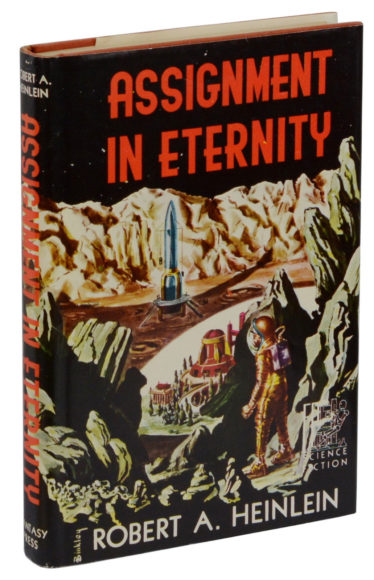
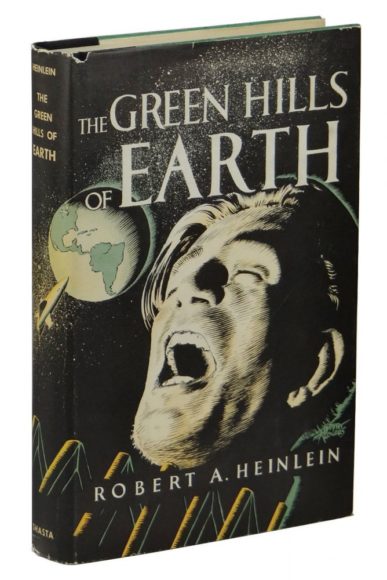
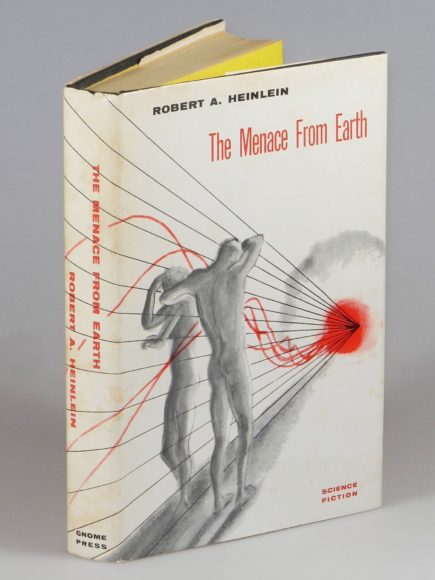
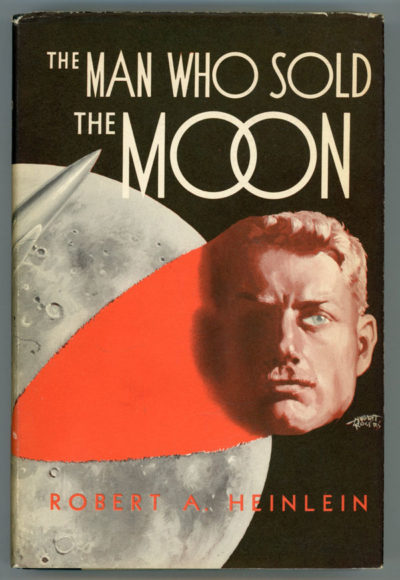
Seeing the Future
I’ve been having a lot of fun collecting digital scans of old pulp magazine covers. It’s great killing time on the Facebook group, Space Opera Pulp, where several thousand other fans of pulp magazines hang out. I save images to a folder called “SF Covers” and use a program, John’s Background Switcher to randomly display them on my computer’s desktop background. (It’s a free program for Windows and Mac computers.)
Then, when I want to take a break I’ll watch a slideshow of science fiction art. Sometimes I listen to a podcast or audio books while watching. I tell JBS to switch images every 15 seconds. It’s pleasantly meditative.
However, this activity is also proving educational. Not only am I seeing a visual history of the science fiction genre, but I’m learning how people saw the future over time. For example, the cover from Amazing Stories, November 1928 shows a rather steampunky spaceship landing on one of the moons of Jupiter. Remember, real rockets had yet to be invented.

Spaceships got very weird, and very long, in the 1930s. And they also imagined some very strange machines. It’s always funny to see current-day technology adapted to look futuristic.
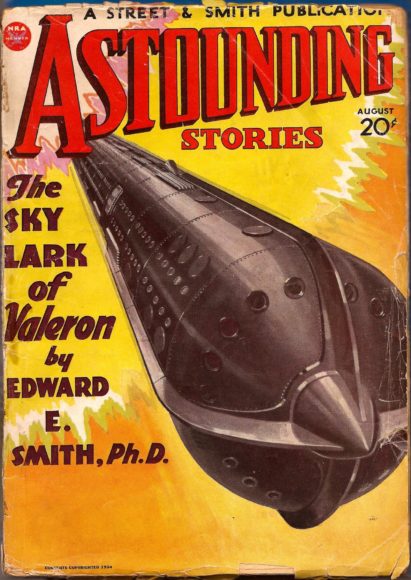

Now take a look Cosmic Science Fiction, July 1941. How many people understood the concept of weightlessness back then? I’m quite impressed with the artist here. I’m not sure if I ever read an old story that conveyed so much in words as what’s drawn here in pen and ink.
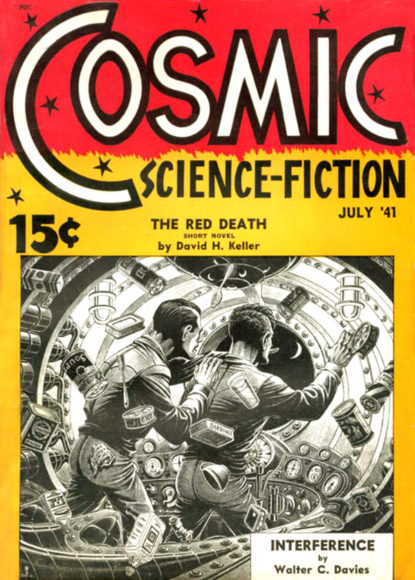
Planet Stories, with its notoriously lurid covers, gives another vision of the future. Atomic Blondes have been around a lot longer than that current film in the theater. This artist isn’t imagining our real future, but the future of comic books and Star Wars.

My friend Mike tells me the art in Planet Stories is corny now, but I think it captures a forgotten era. Take a look at “Galaxy Babes: The Gaudy, Brazen Cover Art Of Planet Stories” to get a better sense of its style. I get the feeling these covers convinced a good many adolescent boys in the 1940s to read science fiction. Another popular magazine was Captain Future because it had a similar artistic style on its covers.
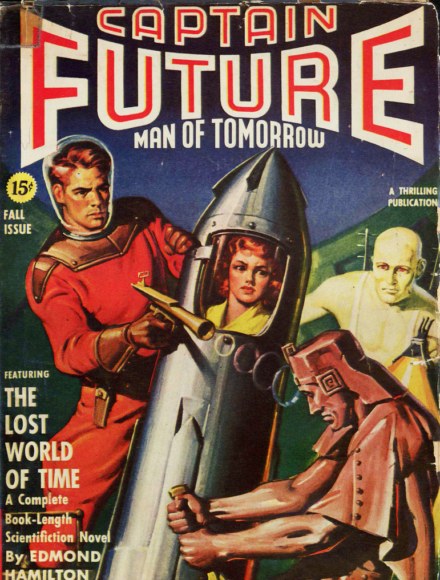
One thing I love about the old pulp art is the cover often told a story by itself. There are folks who collect 1950s paperback books because of their visually gripping covers and I think it’s for that same reason artists were so important to the pulps. I’m not sure people would collect them if they didn’t have the cover art they did. The illustrators captured a moment of action and it makes you want to buy the book/magazine to find out what happens next. Modern covers don’t do that. I wonder if 21st-century books and magazines would sell better if their covers showed in-the-moment action?
Just look at the covers below – don’t they make you want to read the stories?
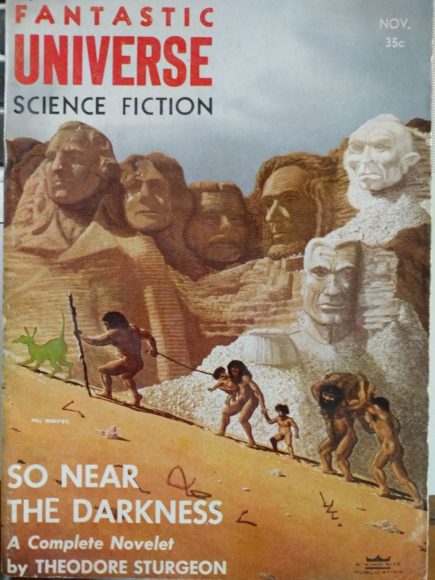
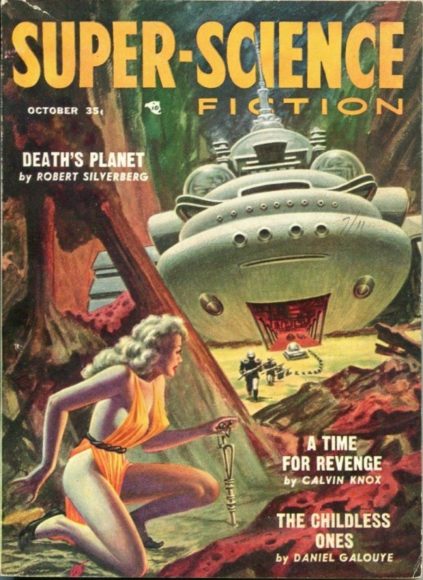
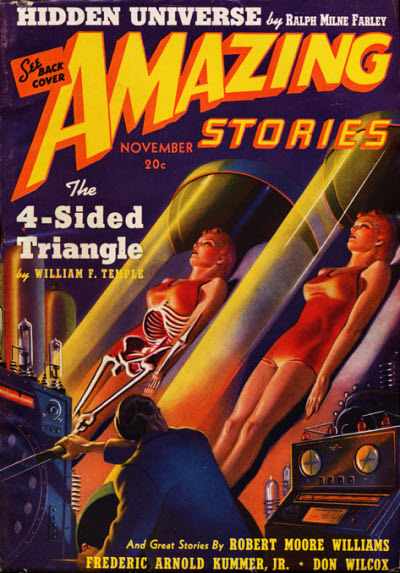
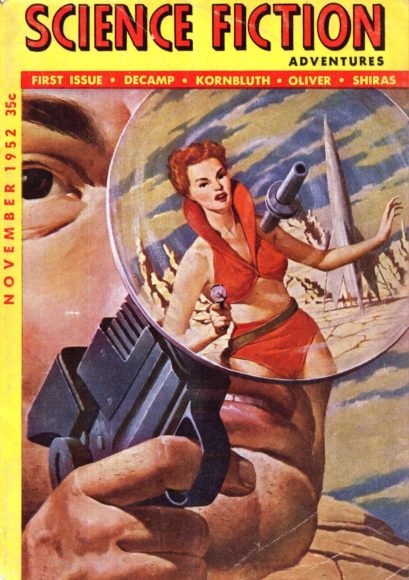


JWH
Big Headed Humans With Telepathy
 Our online science fiction book club is reading Before the Golden Age edited by Isaac Asimov and discussing one story a week. The first story is “The Man Who Evolved” by Edmond Hamilton, first appeared in the April 1931 issue of Wonder Stories. The story is very old fashioned, about a mad scientist, Dr. John Pollard, inviting two friends to observe an experiment. The narrator, Arthur Wright, describes what he and Hugh Dutton see when Pollard subjects himself to distilled cosmic rays.
Our online science fiction book club is reading Before the Golden Age edited by Isaac Asimov and discussing one story a week. The first story is “The Man Who Evolved” by Edmond Hamilton, first appeared in the April 1931 issue of Wonder Stories. The story is very old fashioned, about a mad scientist, Dr. John Pollard, inviting two friends to observe an experiment. The narrator, Arthur Wright, describes what he and Hugh Dutton see when Pollard subjects himself to distilled cosmic rays.
Wikipedia has a nice summary. You can read the story online in a scan of April 1931 Wonder Stories. Also, here’s a “Retro Review” that’s rather nice.
The setting is like something out of Frankenstein. Pollard has built a machine that gathers cosmic rays, which he believes is the agent of evolution. Each 15-minute exposure will alter his body as if had evolved for 50 million years. Wright and Dutton watch Pollard transform six times, each time his brain grows larger and his body becomes smaller. Pollard acquires telepathy and vast knowledge. Of course, all this is ridiculously unscientific. However, Hamilton is using the story to imagine what will happen to humans in the future. Hamilton is mining the same motherload as Olaf Stapledon, H. G. Wells, and many other early science fiction writers when they thought about the future of our species.
 I love reading old science fiction stories like this because they give perspective on the nature of science fiction. You must ask yourself when you read such a tale, “What other science fiction stories have explored the same theme?” Right off the bat I thought of The Time Machine by H. G. Wells, First and Last Men by Olaf Stapledon, Childhood’s End by Arthur C. Clarke, and Darwin’s Radio by Greg Bear – and of course “The Sixth Finger” from the old TV show, The Outer Limits, which featured a plot that Hamilton should have sued them over.
I love reading old science fiction stories like this because they give perspective on the nature of science fiction. You must ask yourself when you read such a tale, “What other science fiction stories have explored the same theme?” Right off the bat I thought of The Time Machine by H. G. Wells, First and Last Men by Olaf Stapledon, Childhood’s End by Arthur C. Clarke, and Darwin’s Radio by Greg Bear – and of course “The Sixth Finger” from the old TV show, The Outer Limits, which featured a plot that Hamilton should have sued them over.
What all these stories boil down to is this: What will Humans 2.0 be like? Time and time again science fiction predicts people with ESP abilities. 1950s science fiction was full of such stories. And quite often, they predicted people with larger heads. Star Trek often featured many big headed aliens – the first pilot which became the episode “The Menagerie” featured big-headed aliens with telepathy.
I don’t think humans will ever evolve to have ESP powers. But we will create a species of intelligent machines that will have telepathy with radio waves and networking.
I am rather bothered by the constant desire to see humans have telepathy, telekinesis, clairvoyance, precognition and other wild talents. Aren’t they the same talents we assigned in the past to God and gods – prayer, the invisible hand of God, and prophecy? The reason why this country is so politically divided today is most citizens reject science for magic. They can’t accept evolution or global warming because it means giving up on an immortal soul and heaven.
Why can’t science fiction imagine evolution creating non-magical abilities for us? I consider science fiction failing if all it can come up with for our future evolution is reprocessed abilities from myths and religions. The insights of The Enlightenment are evolutionary. Compassion is evolutionary. Technology is evolutionary. Global cooperation is evolutionary. Computers and networking are evolutionary.
What natural abilities could we expect for biological evolution to give us in the future? I think the epitome of gifts would be a better understanding of reality without the desire for magic. If you watch the nightly news what we need is better bullshit detectors rather than telepathy. Personally, I’d like a better memory or a body that’s less prone to disease and decay. I wish I could synthesize more information and model bigger concepts in my head. I admit that telepathy could be useful, but I just can’t see any way that nature would give us built in radios. However, I can imagine us becoming more empathetic. Could that lead to being able to read each other’s moods or feelings?
 One lesson I’ve learned from writing is my thoughts are not very coherent. It takes a lot of writing and editing to make them gel into something understandable. I’m not sure telepathy would be very effective. Writing takes work and time, and even then, it’s very hard to make a coherent message that others will read and interpret in the same way it was intended.
One lesson I’ve learned from writing is my thoughts are not very coherent. It takes a lot of writing and editing to make them gel into something understandable. I’m not sure telepathy would be very effective. Writing takes work and time, and even then, it’s very hard to make a coherent message that others will read and interpret in the same way it was intended.
Let’s say you are Edmond Hamilton in 1931 and want to convey the ideas of “The Man Who Evolved” to friends. Would telepathy have worked better than Wonder Stories?
I think science fiction needs to get out of the rut of big headed humans with ESP.
What’s Your Science Fiction Fantasy?
Have you ever wanted to write a science fiction novel? Do you picture yourself as the hero? Be honest – do you have what it takes to be a great protagonist? And just what kind of adventure would you want to have?
Novels, unlike real life, and especially for science fiction, can be about anything. But let’s get really far out. Let’s imagine you have died, and you regain consciousness. You’re in an empty room with another being. Let’s not be so pedestrian as to call it God. Let’s just say it’s a very advanced being with great powers. The being tells you how reincarnation works. You can now be sent anywhere in the multiverse to live again. Just pick. The multiverse is so infinite anything you can imagine exists somewhere. Just think what you want. Or you can volunteer to be randomly placed.
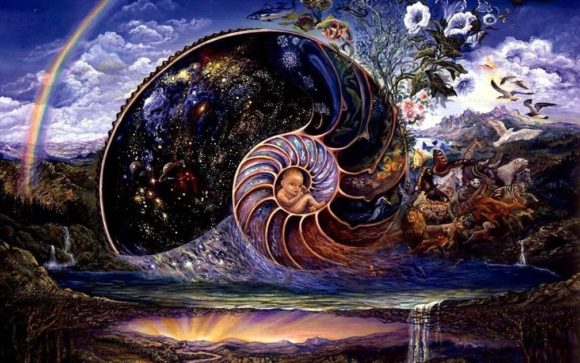
Do you have a favorite book or movie you’d like to live? Have you been refining a personal fantasy for years you want to try out? Think hard and long, because like a Genie with three wishes, your decision can come back to bite you in the ass. Do you want to stay on Earth, or venture out into the solar system, or beyond? Do you want to be rich? Have lots of sex? Travel far and wide? Invent wonderful machines? Do great deeds? Be a great leader? Spend a lifetime being compassionate?
Think about your favorite novels. Good ones usually involve much adversity and danger. Have you ever read Replay by Ken Grimwood? Jeff Winston, the novel’s protagonist dies at 43 and wakes up back in 1963, in his 18-year-old body to live his life again. He remembers his first life, so he tries to make his second life better. It doesn’t work out like he plans. (Do plans ever work out like planned?) Jeff dies again and gets yet another chance. Thus the title. This 1986 novel came out well before Groundhog Day in 1993. This is one of my favorite fantasies.
When I was younger, I would have picked being a colonist on Mars. Either like Heinlein’s Red Planet or Robinson’s Red Mars. Or maybe a person using suspended animation to see the future like Heinlein’s The Door Into Summer. Of course, having a time machine like the traveler in H. G. Wells’ The Time Machine would be fantastic. I can’t think of anything more rewarding than going up and down the timeline of Earth to see what happens in both the past and the future.
However, I’d still pick the Ken Grimwood type of adventure. I’d like to reincarnate into my 12-year-old self and try this life again, starting in 1963. (Strange that Grimwood and I both picked 1963.) That was the year my family moved from Miami to South Carolina. I’ve always wondered if I could have convinced my folks to let me stay with my grandmother instead. She lived alone and managed an apartment building for old people. I even met a woman there who had been on the Titanic. My grandmother could have used the help, and I could have made a much better life knowing what I know now – if I had tried harder. It would be rewarding to live another life doing everything differently.
Hinduism invented the idea of reincarnation to improve the soul. It’s a rather elegant idea once you think about it. Especially, if you could reincarnate into your own life for a second try. It’s taken me almost seven decades to figure out how things work. Would knowing what I know now at puberty make much of a difference? It would be fascinating to find out.
Science fiction is really a literature of imagining alternate lives using all of time and space. Most of the time we explore wishes gone bad. I think that’s why I’ve always loved the twelve Heinlein juvenile novels the most of any science fiction stories. Those stories published from 1947-1958 had a lot of bad things happen to the characters, but the sense-of-wonder adventures made up for any of the sufferings.
If you have the time, leave a comment about the choice you’d make.
Are You Nostalgic for Old SF Art?
I recently joined two groups on Facebook devoted to science fiction art: Raypunk and Space Opera Pulp. It makes me wonder: How many people love science fiction art? Over the years I’ve encountered a number of blogs devoted to SF art like Joachim Boaz’s Science Fiction and Other Suspect Ruminations and 70s Sci-Fi Art. And more databases of covers from science fiction magazines are showing up, like The Magazine of Fantasy and Science Fiction from Phil Stephensen-Payne’s giant website. Even the Internet Science Fiction Database has become much more cover oriented. If you search Pinterest for “science fiction art” you’ll get countless collections.

Raypunk features more modern SF artwork but does include some older stuff. Space Opera Pulp is exactly what it says, and more to my nostalgic tastes. I would love to include samples of art these sites provide but I’m not sure about the rules of copyright violations.

It would be a wonderful blogging project to show the evolution of science fiction art as it parallels written science fiction. But I’m not sure how when it comes to getting permissions to use artwork. For now, I’m showing screenshots to these sites as a colorful enticement to try them. Here are some of the covers from F&SF. If you go to the site and click on a thumbnail it will show the large view. However, if you love a particular cover search for it on Google using the image view. Often larger higher resolution images are available.
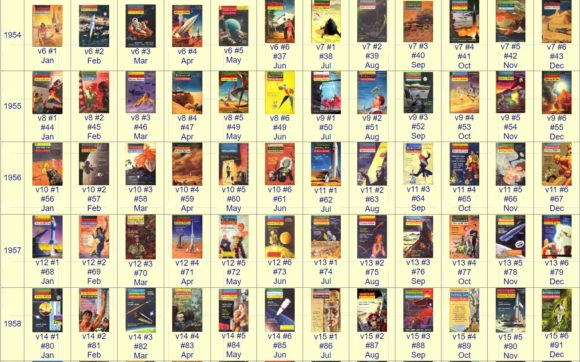
For my personal use, I just right-click on images, select “Save image as…” and then put them into my SF Art folder. I search for the best scan at the highest resolution, and use my computer’s desktop background as an art gallery, using John’s Background Switcher to change images. It’s available for free and works on Windows and Mac. For Linux, I use Variety Wallpaper Changer. These programs automatically switch desktop background images at set time intervals. Here’s what my current desktop looks like:
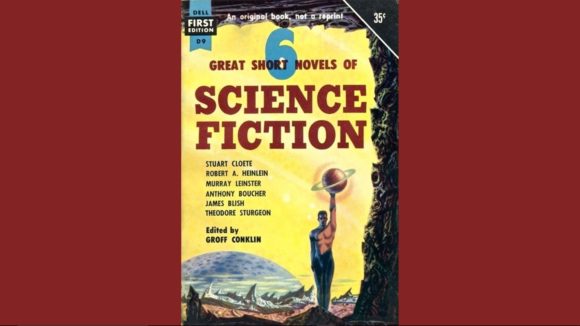
One idea for a visual essay would be to take a single topic, say Mars, and show how fiction and illustrations have changed over time. Go year-by-year describing stories, quoting them, and showing the illustrations. Of course, that’s just another project to put on my pile of projects-to-do, but it would be fun. If anyone knows about the copyright laws that would apply to such a project, leave a comment, please.
Another project would be to pick one artist, say Richard Powers, and show how their work changed with the science fiction times. ISFDB makes that easy. They list books by cover artist. I assume showing whole book covers are kosher when it comes to copyright.
That should allow a project showing all the covers for a particular book. Here’s the ISFDB page for Have Space Suit-Will Travel. It goes on and on.
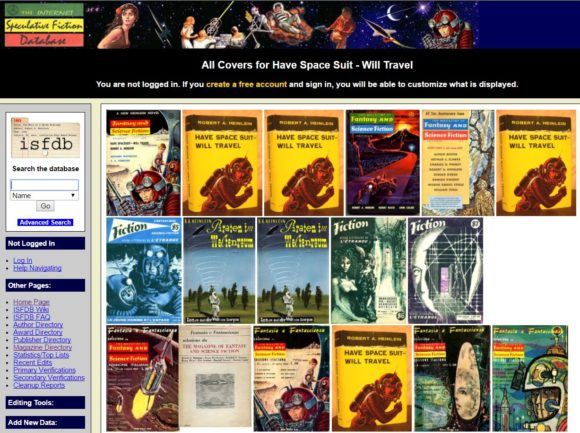
But really, how many fans of SF art are out there? Is it in the hundreds, the thousands? I can’t imagine it in the tens of thousands, but maybe. Wouldn’t it be funny to find out if 167 people keep all those SF art websites going? I think they must come in two kinds. The folks that love the current work, and the folks that are nostalgic like me.
I think that because I believe that’s how people read science fiction. When you’re young you read new science fiction to imagine the future. When you’re old you read the old science fiction you loved when young and think about the past.
Here’s the desktop image as I finished this essay.
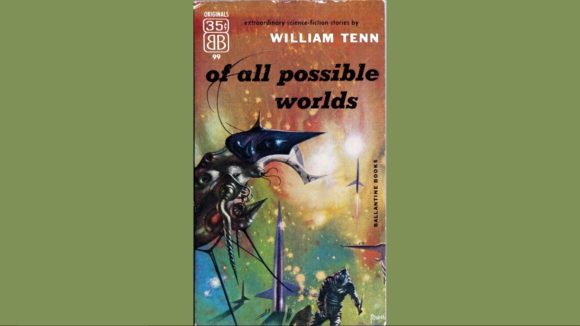
Cuteness in Science Fiction
I recently reread Little Fuzzy by H. Beam Piper and realized it’s success was probably due to cuteness. Cuteness is hard to define but generally deals with little creatures like kittens, puppies, babies, and toddlers. In the case of science fiction, cuteness comes in the form of little aliens or small robots.
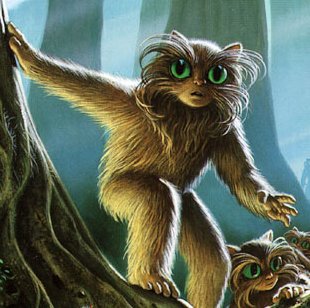
Little Fuzzy was a read for my science fiction book club and most of the members enjoyed a story about cute critters being discovered by a gem miner on a distant planet. Piper’s plot examined what makes a being sentient, which is a serious, non-cute subject. However, because of the enduring popularity of fuzzy stories, we could also say Piper explored the concept of cuteness in science fiction. If you want to know more about the series read “The Fuzzy Story.”
I always pictured fuzzies sort of like Gizmo from Gremlins. Big eyes, small, furry – all the elements of cuteness. Big eyes seem to be a major element of anime. And, furry leads to furry fandom. I wonder if furries were inspired by Piper’s fuzzies? I’m not a fan of anime or furry so I’m not sure how they emerged, but I have to assume some form of cuteness was at the heart of their inspiration. Science fiction has always appealed to the young, and young at heart, so such subgenres of cute F&SF have their fans. I’m not one, but I do see cuteness as a hook for writers.
John Scalzi wrote a remake called Fuzzy Nation that has sales-appeal because of the cuteness of fuzzies.
 Science fiction is seldom about cute – but when science fiction does get cute, those stories are often fondly remembered. Just think of “Trouble with Tribbles,” David Gerrold’s classic Star Trek episode. Of course, I thought Tribbles were a rip off of Flat Cats from The Rolling Stones by Robert A. Heinlein, which had its cuteness appeal. And I have to assume the idea of cute critters that multiply quickly wasn’t original with Heinlein. One of the flat cats was named Fuzzy Britches. So fuzzies might have also come from flat cats.
Science fiction is seldom about cute – but when science fiction does get cute, those stories are often fondly remembered. Just think of “Trouble with Tribbles,” David Gerrold’s classic Star Trek episode. Of course, I thought Tribbles were a rip off of Flat Cats from The Rolling Stones by Robert A. Heinlein, which had its cuteness appeal. And I have to assume the idea of cute critters that multiply quickly wasn’t original with Heinlein. One of the flat cats was named Fuzzy Britches. So fuzzies might have also come from flat cats.
Cuteness is often linked to humor, like a cousin to comic relief. If the fuzzies hadn’t been cute, would Piper’s story had been as successful? Some stories can be improved with a dash of cuteness, but too much can be cloying. Most of the humor in “Trouble With Tribbles” seems strained today. It was saved by the cuteness of tribbles. I tend to think the cute fuzzies saved Piper’s story. It was reasonably well written for its time and market but it wasn’t that original. Piper was a solid genre writer back then, but isn’t well remembered today, except for creating fuzzies.
Pixar and Disney depend on a certain amount of cuteness to drive their genre and non-genre films. If there’s too much cuteness their stories will only appeal to children. Blockbuster animated films depend on attracting audiences of all ages.
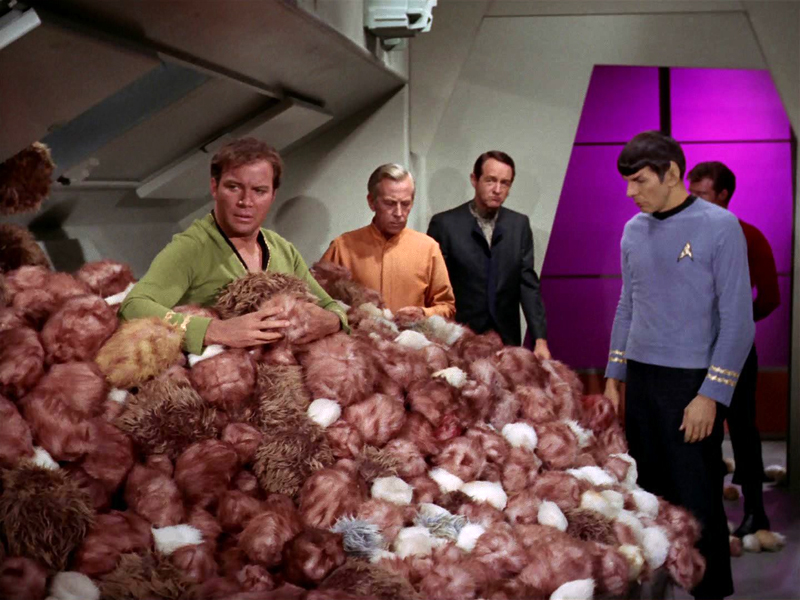 My first encounter with cuteness in science fiction came from Willis, the Martian “bouncer” in Heinlein’s Red Planet. Willis was fuzzy and round like a medicine ball. Willis could protrude eye stalks or other appendages. He whistled. Which reminds me of R2D2. That’s another area of cuteness in science fiction, small robots like R2D2, WALL-E, and the little robots in Silent Running, Huey, Dewey, and Louie (for those people who remember really old science fiction).
My first encounter with cuteness in science fiction came from Willis, the Martian “bouncer” in Heinlein’s Red Planet. Willis was fuzzy and round like a medicine ball. Willis could protrude eye stalks or other appendages. He whistled. Which reminds me of R2D2. That’s another area of cuteness in science fiction, small robots like R2D2, WALL-E, and the little robots in Silent Running, Huey, Dewey, and Louie (for those people who remember really old science fiction).
So cute isn’t always fuzzy, it can be metallic, if small. The Heinlein juveniles had a number of strange alien creatures, but most of them were not cute. Often, cuteness in science fiction is repackaged puppies and kittens, reshaped, with a bit of mischievous intelligence. Hardly original, but it does tap into our fondness for cuteness.
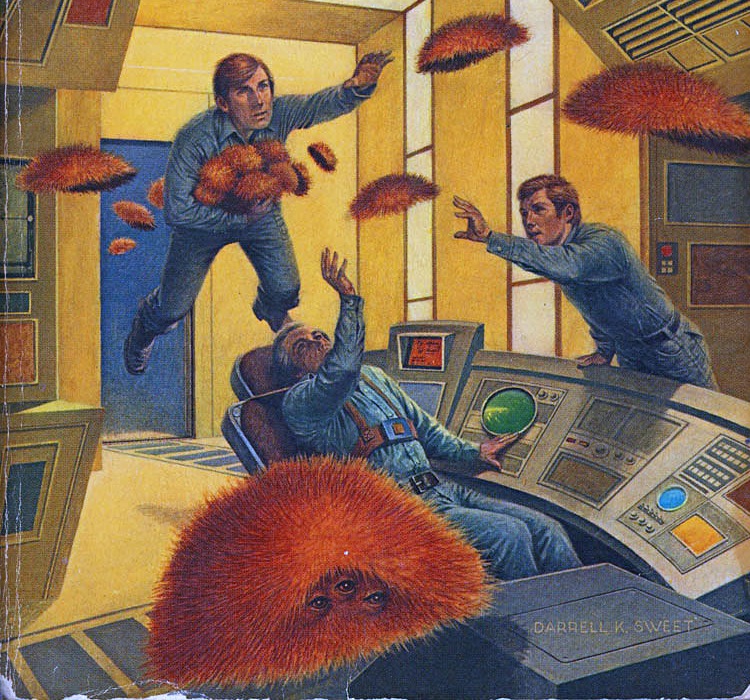 One of the ironic aspects of Little Fuzzy was the main characters wanted to prove fuzzies were sentient, yet they also wanted to own them, treating them like pets. In some science fiction stories, humans have been pets to advanced aliens and we think that evil. Why is it okay when we do it?
One of the ironic aspects of Little Fuzzy was the main characters wanted to prove fuzzies were sentient, yet they also wanted to own them, treating them like pets. In some science fiction stories, humans have been pets to advanced aliens and we think that evil. Why is it okay when we do it?
Cute brings out our maternal and paternal instincts, which is a driving force in the pet industry. However, we’ve cruelly enslaved many species that aren’t suited to domestication. I haven’t read the sequels to Little Fuzzy, but I have to wonder if Piper explored fuzzy exploitation. Cuteness isn’t a great trait for many animals because we’ll cage them for our idle moments when we feel the need to be amused by something small and cute. We also tend to want our kids not to grow up and leave their cute stage, which is unfair. And doesn’t anime and furry fandom encourage arrested development?
We might not see a lot of cuteness in science fiction because it’s something we should limit. Our reality isn’t cute. Maybe I’m an old curmudgeon because I thought the best parts of Little Fuzzy were its serious aspects, and the cute aspects were misguided. Shouldn’t the humans have left the fuzzies alone, and just observed them? Shouldn’t the Prime Directive apply to cute critters too?
When Did You Discover Time Travel?
 How old were you when you first encountered the concept of time travel? I used to believe it was when I first saw the George Pal version of The Time Machine which came out in 1960, and I didn’t see until 1962 or 1963 when I was ten or eleven. Memory is a highly unreliable resource, especially for dating. I vaguely remember that seeing the movie made me get the book from my school library the next day. What’s weird, is I don’t remember being blown away by the idea of a time machine at that time. And time travel is certainly a concept that was mind blowing. What I remember, was being blown away at the idea that humans could mutate into new species. Now that was something to think about.
How old were you when you first encountered the concept of time travel? I used to believe it was when I first saw the George Pal version of The Time Machine which came out in 1960, and I didn’t see until 1962 or 1963 when I was ten or eleven. Memory is a highly unreliable resource, especially for dating. I vaguely remember that seeing the movie made me get the book from my school library the next day. What’s weird, is I don’t remember being blown away by the idea of a time machine at that time. And time travel is certainly a concept that was mind blowing. What I remember, was being blown away at the idea that humans could mutate into new species. Now that was something to think about.
My guess is I already knew about time travel. But when did I first encounter the idea?
In past decades I assumed all the great science fiction concepts like aliens, robots, time travel, interstellar travel, artificial intelligence came from reading science fiction. But in more recent years, as I wrote about my past, struggling to get the facts right, I realized that assumption was wrong. This line of thought started when I tried to remember when I first learned about dinosaurs. I wondered why little kids love dinosaurs, and if they understood dinosaurs existed millions of years ago and are now extinct. Those are heavy concepts too – vast times and extinction. I remember having dreams about dinosaurs when I was four or five, well before I could read, or attend school. And I don’t remember my parents telling me about dinosaurs. How did I learn about them?
Finally, I assumed I was introduced to all the far out ideas of science fiction via television, even though I grew up in the 1950s when television was primitive. That’s why I’ve felt I’ve always known about outer space, robots and traveling through time. Hell, I might have been exposed to time travel before I could tell time.
Evidently, childhood was a phase when my mind was a mass of proto-concepts gathered from television – like Pangaea before splitting into distinguishable continents. Reading science fiction shaped those vague impressions into precise concepts. Although reading Time Travel by James Gleick made me realize that time travel is a tremendously complex subject that we continue to refine.
Now here’s the thing I really want to talk about. In this age of alternate facts, should we be raising kids by stuffing them with fantasy and fantastic beliefs before they understand the nature of reality? We believe that make-believe is perfect for young minds, but is that true? Can you imagine a different way, where we taught kids facts first, and then later introduced them to fantasy?
Can you imagine growing up only seeing science shows that carefully explained what we know and how we know it? How would that change society? Would a fact-based early childhood education make us more realistic about reality? Is fiction the driving force that makes us constantly reshape reality with alternative facts? Does fantasy consumption encourage fantasy viewpoints? What an idea for a science fiction/fantasy novel! Imagine our world without science fiction and fantasy.
Let’s consider one more thing. What if we raised kids without fiction — at what age would they invent time travel on their own? When would they imagine building robots that could think like people, or traveling to Mars? Do we cheat our kids by telling them about all the far out ideas before they could invent them on their own?
Science fiction is a technology for transmitting speculative ideas, ones that writers have predigested for us, sort of like when Neo in The Matrix is taught martial arts with a program injected into his brain. I’m just wondering if we’d have more grit if we acquired our concepts through working out ideas ourselves.
Recommended Recent Reads:
- The Making of Future Man – James Gleick writes about Hugo Gernsback
- 30 years of Culture: what are the top five Iain M Banks novels?
- Disunion: Vision of Our Fragmented Future – Paul Di Filippo
- Beware the Retrofuture: Elan Mastai and Jack Womack Navigate the Problems of SciFi Nostalgia
- Groundhog Day Breaks the Rules of Every Genre



















 Full Details
Full Details

